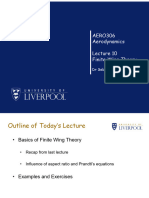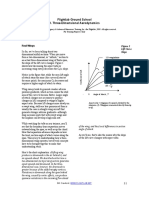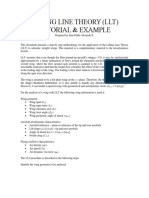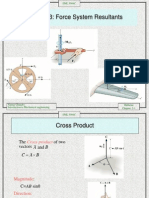Lecture8 LiftingLineTheory
Uploaded by
Anh NguyenLecture8 LiftingLineTheory
Uploaded by
Anh Nguyen10/16/2015
Lifting Line Theory
Overview:
Induced angle of attack
Spanwise lift distribution
Lift curve slope of finite wingspans
Induced drag
Wing Twist
Stall
Lifting Line Theory
Lanchester (1907) described conceptually the effects on
wings with finite wingspans
Prandtl (1918) developed first methods do model and
predict lift and drag behavior of 3-D wing lifting line
thoery
Hess (1950) developed first numerical vortex lattice
method
Lifting line theory and vortex lattice methods are still in use
computationally very fast and accurate.
We will focus on LLT, because a lot of insight to what occurs
on 3-D wing.
10/16/2015
Lifting Line Model
Assumptions:
AR >5
Wing modeled by single bound vortex with a continuously
changing circulation distribution (y)
Wake vorticity is derivative of bound circulation
Effect of trailing vortex system on lifting line can be
reduced to change in angle of attack
Looking at a section of the wing
The section lift is given by:
1
Thus, in terms of the section lift coefficient: ( y ) 2 cl ( y )c ( y )V
The total lift of the wing is given by:
Without physical boundaries at the wingtips, lift and circulation
approach zero.
Thus, lift and circulation change continuously across span by dL and d.
dL( y ) V ( y ) 1 V 2cl ( y )c ( y )
2
b/2
L
1 2 V
2c ( y )c ( y )dy
l
b / 2
As circulation changes continuously from to +d, vorticity d is shed
in order to satisfy the Helmholtz theorems
10/16/2015
Looking at a section of the wing
Using the Biot-Savart law, we can evaluate the downwash at wing section y0: due to a
circulation (y):
d ( y )
dw ind ( y 0 )
4 ( y 0 y )
Thus, the total induced angle of attack at span location y0 is given by:
Can be
ind ( y 0 )
d induces a downwash at wing section y0.
That downwash result in an induced angle of
attack ind:
wind ( y 0 )
1
V
4V
b/2
b / 2
solved if
is known
d ( y )
( y0 y )
Remember, the local section lift coefficient is related to the local angle of attack:
Cl ( y 0 ) Cl ind ( y 0 )
Another Transformation
Using a transformation similar to thin airfoil theory:
This yields for the integral of the induced angle of attack:
ind ( y 0 )
1
2bV
b
cos
2
d ( )
cos cos0
0
This can be easily integrated, for example by assuming to be of a given
function such a Fourier series.
The result yields the local angles of attack, thus also the local lift coefficients:
Cl ( y 0 ) Cl ind ( y 0 )
It can also be used to compute the local section induced drag.
We will focus on the special case of an
elliptical load distribution.
10/16/2015
The Elliptical Load Distribution
The elliptical load distribution is a special case in literature. Theoretically, it
has the least induced drag (more about this later). Also, it has a constant
downwash across the wingspan.
Lets assume an elliptical load (circulation) distribution across the wingspan:
( y ) 0 1
2y
( ) 0 sin
The transformed distribution becomes relatively simple:
The subsequent solution of the integral for the induced angle of attack is:
ind
0
2bV
no dependency on y!!
Also b, V ind
This also means that if the wing has no twist, the local lift coefficient is equal to
the overall lift coefficient: Cl=CL! This means, that the chord distribution has to be
elliptical:
2
2y
c ( y ) c0 1
b
The Elliptical Wing
According to lifting line theory, a wing that has an elliptical planform and has
no twist will produce an elliptical circulation and lift distribution. Such a wing
will have a constant downwash and section lift coefficient across the span!
Since the induced angle of attack is constant across the span we can easily
relate angle of attack and lift.
2
2y
1. Use CL for cl
( y ) 0 1 1 2VCL ( y )c ( y )
b
2. Solve for chord
3. Use elliptical chord and
circulation relationships
2
2y
4. This yields for the
c ( y ) c0 1
c0CL
b
induced AOA: ind
4b
2
5. For elliptical planforms: AR b 4b
S c0
6. This yields:
ind ellipt
CL
AR
10/16/2015
The Elliptical Wing
Remember:
Cl ( y ) Cl ind
no twist =0
CL Cl L
AR
Cl=CL for elliptically loaded wing
This can be solved for CL :
This relationship between 2-D and 3-D lift works really well:
AR
CL Cl
AR 2
In order to get the same CL with a lower AR wing,
the AOA has to be larger than in the case
of a larger AR wing!
Angles of Attack on Wing and Airfoil
You might also like
- Modern Adaptation of Prandtl's Classic Lifting-Line Theory: Utah State University, Logan, Utah 84322-4130No ratings yetModern Adaptation of Prandtl's Classic Lifting-Line Theory: Utah State University, Logan, Utah 84322-41309 pages
- Modern Adaptation of Prandtl's Classic Lifting-Line Theory100% (1)Modern Adaptation of Prandtl's Classic Lifting-Line Theory9 pages
- Mae 3241: Aerodynamics and Flight Mechanics: Finite Wings: General Lift Distribution SummaryNo ratings yetMae 3241: Aerodynamics and Flight Mechanics: Finite Wings: General Lift Distribution Summary21 pages
- Module-3 Association Analysis: Data Mining Association Analysis: Basic Concepts and AlgorithmsNo ratings yetModule-3 Association Analysis: Data Mining Association Analysis: Basic Concepts and Algorithms34 pages
- The Wyoming Legislature: A Citizen Guide To100% (1)The Wyoming Legislature: A Citizen Guide To24 pages
- Aerodynamics of A Wing Fundamentals of The Lifting-Line TheoryNo ratings yetAerodynamics of A Wing Fundamentals of The Lifting-Line Theory25 pages
- Mae 3241: Aerodynamics and Flight Mechanics: Introduction To Lifting Line TheoryNo ratings yetMae 3241: Aerodynamics and Flight Mechanics: Introduction To Lifting Line Theory28 pages
- JoA Vol41 No1 Lifting Line Analysis For TwistedWings and Washout OptimizedWingsNo ratings yetJoA Vol41 No1 Lifting Line Analysis For TwistedWings and Washout OptimizedWings9 pages
- Three-Dimensional Small-Disturbance Solutions Disturbance SolutionsNo ratings yetThree-Dimensional Small-Disturbance Solutions Disturbance Solutions19 pages
- Lecture 5 - Incompressible Flow Over A Finite WingNo ratings yetLecture 5 - Incompressible Flow Over A Finite Wing38 pages
- Chapter 5: Incompressible Flow Over Finite WingsNo ratings yetChapter 5: Incompressible Flow Over Finite Wings54 pages
- Fluids - Lecture 5 Notes: Introduction To 3-D WingsNo ratings yetFluids - Lecture 5 Notes: Introduction To 3-D Wings4 pages
- VND - Openxmlformats Officedocument - Presentationml.presentation&rendition 1No ratings yetVND - Openxmlformats Officedocument - Presentationml.presentation&rendition 156 pages
- Chapter 5 - IncompressibleFlowOver - FiniteWingNo ratings yetChapter 5 - IncompressibleFlowOver - FiniteWing18 pages
- LIFTING LINE THEORY - Tutorial Example - PDFNo ratings yetLIFTING LINE THEORY - Tutorial Example - PDF28 pages
- Local Momentum Theory and Its Application To The Rotary WingNo ratings yetLocal Momentum Theory and Its Application To The Rotary Wing9 pages
- AERODYN2-Part-23-and-4-Circulation-Aspect-Ratio-Correction-Drag (Final Version)No ratings yetAERODYN2-Part-23-and-4-Circulation-Aspect-Ratio-Correction-Drag (Final Version)52 pages
- Post Stall Behavior of A Lifting Line AlgorithmNo ratings yetPost Stall Behavior of A Lifting Line Algorithm7 pages
- Estimating The Low-Speed Downwash Angle On An Aft Tail: W. F. Phillips, E. A. Anderson, J. C. Jenkins, and S. SunouchiNo ratings yetEstimating The Low-Speed Downwash Angle On An Aft Tail: W. F. Phillips, E. A. Anderson, J. C. Jenkins, and S. Sunouchi9 pages
- Naca TM 1120 The Lift Distribution of Swept-Back Wings Naca 1947 (Weissinger J) PDFNo ratings yetNaca TM 1120 The Lift Distribution of Swept-Back Wings Naca 1947 (Weissinger J) PDF51 pages
- Modeling of Complex Systems: Application to Aeronautical DynamicsFrom EverandModeling of Complex Systems: Application to Aeronautical DynamicsNo ratings yet
- Hyperbolic Structures: Shukhov's Lattice Towers - Forerunners of Modern Lightweight ConstructionFrom EverandHyperbolic Structures: Shukhov's Lattice Towers - Forerunners of Modern Lightweight ConstructionNo ratings yet
- Standard-Slope Integration: A New Approach to Numerical IntegrationFrom EverandStandard-Slope Integration: A New Approach to Numerical IntegrationNo ratings yet
- The Mechanics of Water-Wheels - A Guide to the Physics at Work in Water-Wheels with a Horizontal AxisFrom EverandThe Mechanics of Water-Wheels - A Guide to the Physics at Work in Water-Wheels with a Horizontal AxisNo ratings yet
- Group-Contribution Estimation of Activity Coefficients in Nonideal Liquid Mixtures. Aiche 1975No ratings yetGroup-Contribution Estimation of Activity Coefficients in Nonideal Liquid Mixtures. Aiche 197514 pages
- Orthoptic Exercises Information Leaflet: OphthalmologyNo ratings yetOrthoptic Exercises Information Leaflet: Ophthalmology5 pages
- Mina Petrila-Spatiu Exterior 2 - 14 03 2024-ModelNo ratings yetMina Petrila-Spatiu Exterior 2 - 14 03 2024-Model1 page
- (Ebook) Pulp & Paper Chemistry & Technology V1 - Paper Products Physics and Technology by Monica Ek, Göran Gellerstedt, Gunnar Henriksson (Editors) ISBN 9783110213454, 3110213451 - Download the ebook now to never miss important informationNo ratings yet(Ebook) Pulp & Paper Chemistry & Technology V1 - Paper Products Physics and Technology by Monica Ek, Göran Gellerstedt, Gunnar Henriksson (Editors) ISBN 9783110213454, 3110213451 - Download the ebook now to never miss important information51 pages
- 01- 24 MLD STP Bijnor Power Consume Report January-2025No ratings yet01- 24 MLD STP Bijnor Power Consume Report January-20251 page
- Intel Architecture: 2.1. Brief History of The Ia-32 ArchitectureNo ratings yetIntel Architecture: 2.1. Brief History of The Ia-32 Architecture19 pages
- 10th Samacheer Kalvi Maths EM Public Exam QP Sample 4 PDFNo ratings yet10th Samacheer Kalvi Maths EM Public Exam QP Sample 4 PDF4 pages
- Encyclopedia of Embroidery From The ArabNo ratings yetEncyclopedia of Embroidery From The Arab3 pages
- Tax Planning in Case of Foreign Collaborations and Joint VentureNo ratings yetTax Planning in Case of Foreign Collaborations and Joint Venture3 pages
- Modern Adaptation of Prandtl's Classic Lifting-Line Theory: Utah State University, Logan, Utah 84322-4130Modern Adaptation of Prandtl's Classic Lifting-Line Theory: Utah State University, Logan, Utah 84322-4130
- Modern Adaptation of Prandtl's Classic Lifting-Line TheoryModern Adaptation of Prandtl's Classic Lifting-Line Theory
- Mae 3241: Aerodynamics and Flight Mechanics: Finite Wings: General Lift Distribution SummaryMae 3241: Aerodynamics and Flight Mechanics: Finite Wings: General Lift Distribution Summary
- Module-3 Association Analysis: Data Mining Association Analysis: Basic Concepts and AlgorithmsModule-3 Association Analysis: Data Mining Association Analysis: Basic Concepts and Algorithms
- Aerodynamics of A Wing Fundamentals of The Lifting-Line TheoryAerodynamics of A Wing Fundamentals of The Lifting-Line Theory
- Mae 3241: Aerodynamics and Flight Mechanics: Introduction To Lifting Line TheoryMae 3241: Aerodynamics and Flight Mechanics: Introduction To Lifting Line Theory
- JoA Vol41 No1 Lifting Line Analysis For TwistedWings and Washout OptimizedWingsJoA Vol41 No1 Lifting Line Analysis For TwistedWings and Washout OptimizedWings
- Three-Dimensional Small-Disturbance Solutions Disturbance SolutionsThree-Dimensional Small-Disturbance Solutions Disturbance Solutions
- Lecture 5 - Incompressible Flow Over A Finite WingLecture 5 - Incompressible Flow Over A Finite Wing
- Fluids - Lecture 5 Notes: Introduction To 3-D WingsFluids - Lecture 5 Notes: Introduction To 3-D Wings
- VND - Openxmlformats Officedocument - Presentationml.presentation&rendition 1VND - Openxmlformats Officedocument - Presentationml.presentation&rendition 1
- Local Momentum Theory and Its Application To The Rotary WingLocal Momentum Theory and Its Application To The Rotary Wing
- AERODYN2-Part-23-and-4-Circulation-Aspect-Ratio-Correction-Drag (Final Version)AERODYN2-Part-23-and-4-Circulation-Aspect-Ratio-Correction-Drag (Final Version)
- Estimating The Low-Speed Downwash Angle On An Aft Tail: W. F. Phillips, E. A. Anderson, J. C. Jenkins, and S. SunouchiEstimating The Low-Speed Downwash Angle On An Aft Tail: W. F. Phillips, E. A. Anderson, J. C. Jenkins, and S. Sunouchi
- Naca TM 1120 The Lift Distribution of Swept-Back Wings Naca 1947 (Weissinger J) PDFNaca TM 1120 The Lift Distribution of Swept-Back Wings Naca 1947 (Weissinger J) PDF
- Modeling of Complex Systems: Application to Aeronautical DynamicsFrom EverandModeling of Complex Systems: Application to Aeronautical Dynamics
- Hyperbolic Structures: Shukhov's Lattice Towers - Forerunners of Modern Lightweight ConstructionFrom EverandHyperbolic Structures: Shukhov's Lattice Towers - Forerunners of Modern Lightweight Construction
- Standard-Slope Integration: A New Approach to Numerical IntegrationFrom EverandStandard-Slope Integration: A New Approach to Numerical Integration
- A Complete Course in Physics ( Graphs ) - First EditionFrom EverandA Complete Course in Physics ( Graphs ) - First Edition
- The Mechanics of Water-Wheels - A Guide to the Physics at Work in Water-Wheels with a Horizontal AxisFrom EverandThe Mechanics of Water-Wheels - A Guide to the Physics at Work in Water-Wheels with a Horizontal Axis
- Group-Contribution Estimation of Activity Coefficients in Nonideal Liquid Mixtures. Aiche 1975Group-Contribution Estimation of Activity Coefficients in Nonideal Liquid Mixtures. Aiche 1975
- Orthoptic Exercises Information Leaflet: OphthalmologyOrthoptic Exercises Information Leaflet: Ophthalmology
- (Ebook) Pulp & Paper Chemistry & Technology V1 - Paper Products Physics and Technology by Monica Ek, Göran Gellerstedt, Gunnar Henriksson (Editors) ISBN 9783110213454, 3110213451 - Download the ebook now to never miss important information(Ebook) Pulp & Paper Chemistry & Technology V1 - Paper Products Physics and Technology by Monica Ek, Göran Gellerstedt, Gunnar Henriksson (Editors) ISBN 9783110213454, 3110213451 - Download the ebook now to never miss important information
- 01- 24 MLD STP Bijnor Power Consume Report January-202501- 24 MLD STP Bijnor Power Consume Report January-2025
- Intel Architecture: 2.1. Brief History of The Ia-32 ArchitectureIntel Architecture: 2.1. Brief History of The Ia-32 Architecture
- 10th Samacheer Kalvi Maths EM Public Exam QP Sample 4 PDF10th Samacheer Kalvi Maths EM Public Exam QP Sample 4 PDF
- Tax Planning in Case of Foreign Collaborations and Joint VentureTax Planning in Case of Foreign Collaborations and Joint Venture





























































































